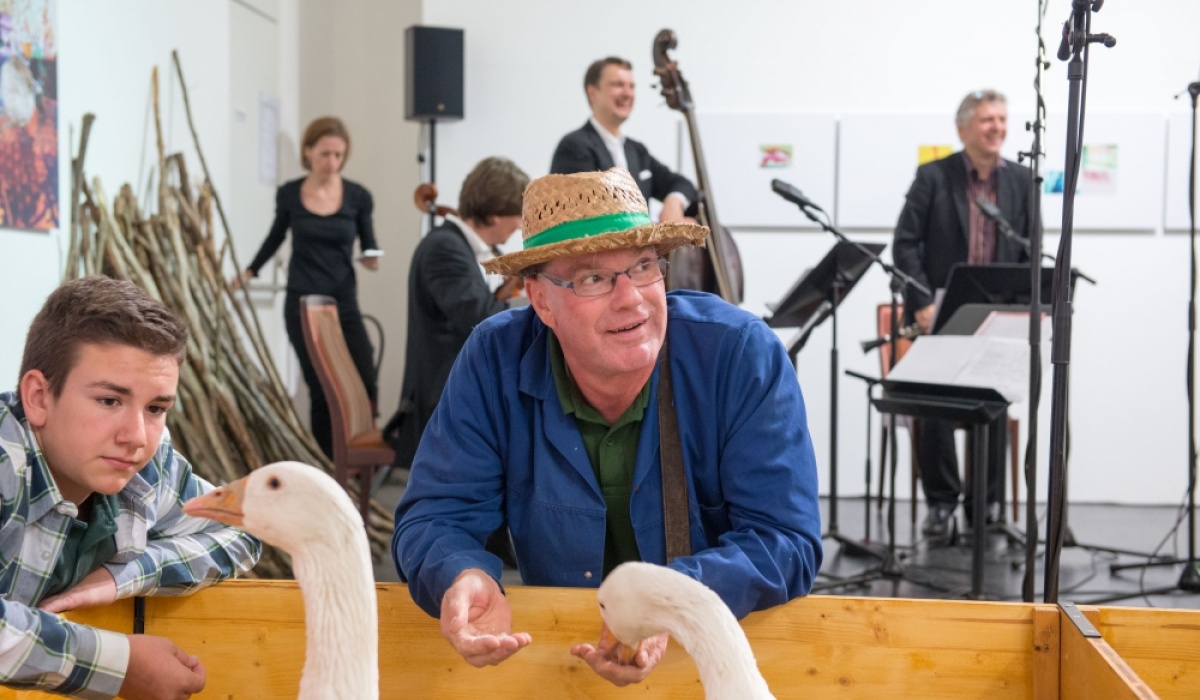
I ask Norbert Math, Andrea Sodomka and Martin Breindl how they came up with the idea of working with birds in the first place.
Sharing Control
Breindl explains that for many years already they have been trying out various ways of sharing the control over the artistic creative process with other people, devices/machines, computers – and for some time now also with animals or birds. Breindl: “We want to create a medium in which intelligences of various kinds can work together to rattle the anthropocentric world view.” In other words, if you take the communicative aspect of art seriously, you automatically arrive at these kinds of solutions.
Part of a System
This is a favourite point of departure for Norbert Math. In the past the group has incorporated into its work various more or less intelligent devices and machines, allowing them to communicate with each other – household appliances, for instance, or wind turbines and hairdryers. To actually work with intelligent creatures, Breindl says, is the next logical step ... and a new challenge because the more intelligent a creature is, the more unpredictable it is too. “What it all comes down to in then end,“ Martin Breindl sums things up, “is recognizing we are all part of a system.”
Scary to Birds, Pleasant to Man
The first project in which Martin Breindl, Andrea Sodomka and Norbert Math worked with living creatures was “RAPTORreloaded”. In 2009 they invited eight sound artists to compose and play electroacoustic works over an acoustic bird control system in a vineyard in Falkenstein. As Math explained, it was almost as if the loudspeaker systems were made for acoustic land art, and according to the project description the aim of the compositions was to be “both aesthetically pleasing and effective in producing a good harvest.”
One of the invited artists, Tetsuo Kogawa, was disinclined to scare away the birds. Instead, the message he sought to convey in his piece was to urge the birds to please not eat the grapes. “And he claimed that by analysing certain frequencies he had discovered how to truly communicate with the birds,” Breindl explains. “I don’t know if that was true, but we found the idea intriguing.”
Dinner with Animals
Last October Martin Breindl, Norbert Math and Andrea Sodomka implemented an idea by the artist Heinz Cibulka by organising the event “Essen mit Tieren” (Dinner with Animals) at the Hermann Nitsch Museum in Mistelbach in conjunction with an exhibition of Cibulka’s work. Humans sat at a table and ate, while beside them animals did the same: geese, sheep, pigs, and rabbits eating side by side with creatures they are normally eaten by. The meal was accompanied by the alien productions composition “Biochemische Tischmusik” (biochemichal dinner music) performed by the ensemble die reihe. Before, during and after, Daniel Lercher wove the sounds of the dining people and animals into a live electronic soundscape.
Daniel Lercher’s Duet with the Geese
“When Daniel Lercher played back the electronically altered honking to the two geese, it triggered a spontaneous duet between the three of them that completely blew us away,” Andrea Sodomka recalls when asked for the most memorable moment of the evening. “Whereas when the ensemble die reihe played, the geese were very quiet and turned their heads and craned their necks toward the ensemble.” Among us humans the common assumption is that animals can only be influenced by classical conditioning, Martin Breindl adds, the so-called Pavlovian reflex. But we're not interested in conditioning and training. “We want to engage in a dialog with the animals and the fact that this took place at least to some extent with the geese makes us optimistic.” Especially after the group discovered that parrots tend to react to acoustic stimuli in much the same way.
Open Call by ECAS
A few months before the “Dinner with Animals” event alien productions responded to our open call for projects. Along with our colleagues from the Unsound, Skanu Mezs and CTM festivals we jointly called for artists to build new bridges to connect what had until then been separate in the spirit of the second phase of our ECAS network project “Networks of Advanced Sound and Related Arts – Bridging cultural sectors and different media and enabling citizen innovation”.
“And all of a sudden, everything fell into place,” Andrea Sodomka tells us. “Our interest in the human-animal relationship, in the zoo situation and also in the inherent technical aspect.” Their work, Sodomka mentions, was also specifically influenced by the zookeeper Peter Dickinson because she found an article on the Internet in which Dickinson posed the question as to why it had as yet never occurred to anyone in the sense of “behavioural enrichment” to invite artists with an affinity for technology to develop toys that might help zoo animals pass the time.
The Next Steps
RAPTORreloaded, Dinner with Animals and now metamusic – these three projects were not consciously intended to build upon each other, Martin Breindl, Norbert Math and Andrea Sodomka admit, but looking back one recognizes a definite pattern, a course even.
In closing I ask: What’s next? For starters, experimenting with and working on building interfaces, says Math. “One idea is to provide parrots with touch screens that let them use their beaks to click certain patterns or kinetic objects like swings.” “And another thing we want to do soon,” Sodomka adds, “is confront the parrots with certain sounds they have probably never heard before to try to find out what their preferences are.” The team zoologist Iris Baldinger, who has already worked intensively with parrots, will help interpret the reactions.
Text: Susanna Niedermayr
Translation: Kimi Lum
Zeit-Ton Wed | 27.2.2013 | 23:03 Uhr Radio Österreich 1
Links:
